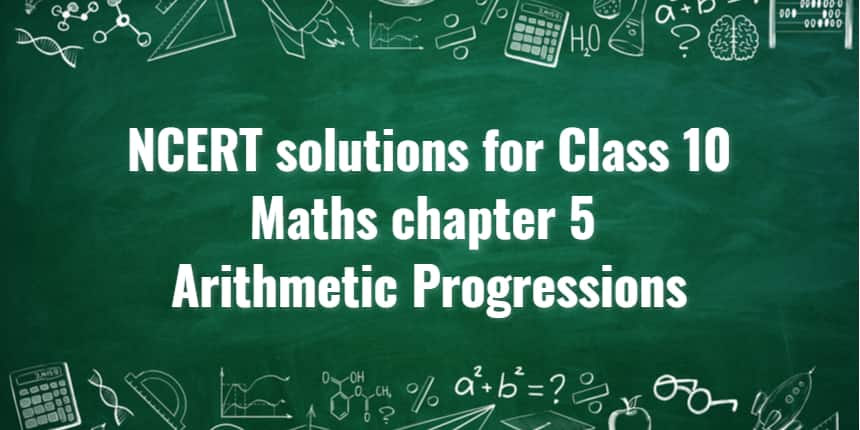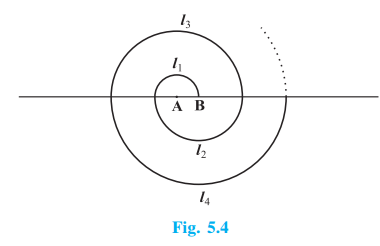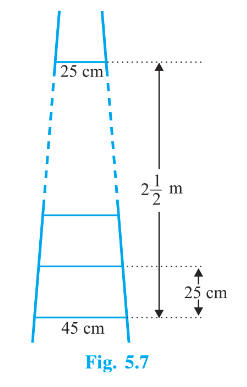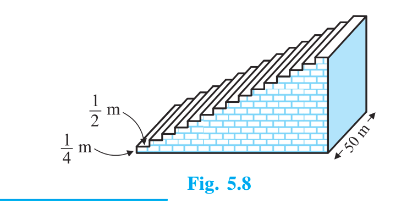NEET/JEE Coaching Scholarship
Get up to 90% Scholarship on Offline NEET/JEE coaching from top Institutes
Imagine a little boy saving Rs. 10 rupees every day and putting it in this piggy bank. After a while, this type of savings forms a pattern and increases by a fixed amount every day. This pattern is also known as Arithmetic progression (AP), which is a fundamental concept in algebra, forming the basis for various advanced topics. An arithmetic progression is a sequence of numbers in which the difference between consecutive terms remains constant. This common difference plays a key role in determining the properties of the sequence. Arithmetic progressions have numerous real-life applications in fields like finance, physics, and computer science.

This article on Solutions of Arithmetic Progressions class 10 Maths NCERT Chapter 5 provides clear and step-by-step solutions for exercise problems in the NCERT Class 10 Maths Book. These solutions of Arithmetic Progression Class 10 are designed by Subject Matter Experts according to the latest CBSE syllabus, ensuring that students grasp the concepts effectively. NCERT solutions for other subjects and classes can be downloaded in NCERT solutions. Students can read the Arithmetic Progression Notes for quick revision purposes. After completing the exercises, they can also practice NCERT Exemplar Solutions for Class 10 Maths Chapter 5 Arithmetic Progression for more clarity.
Arithmetic Progressions (AP) involve a sequence of terms denoted as a1,a2,a3,⋯,an representing a series of integers. A sequence a1,a2,a3,⋯,an,⋯ is called an arithmetic sequence if an+1=an+d,n∈N where d is a constant. Here a1 is called the first term and the constant d is called the common difference. An arithmetic sequence is also called an Arithmetic Progression (A.P.).
An AP maintains a constant difference between consecutive terms, known as the common difference. For terms a1,a2,a3,a4,a5, and a6 in an AP, the common difference can be expressed as D=a2−a1=a3−a2=a4−a3=…
The nth term of an AP is given by the formula, an=a+(n−1)d.
Where
a = First term of the sequence.
n = Term's position in the sequence.
d = Common difference.
The sum of the first 'n’ terms in an AP is calculated using the formula, Sn=n2[2a+(n−1)d]
Where
Sn denotes the sum of the terms.
'n' is the number of terms being summed.
'a' is the first term.
'd' stands for the common difference.
Arithmetic Progressions Class 10 Chapter 5 NCERT Solutions (Exercise)
Below are the NCERT class 10 maths chapter 5 solutions for exercise questions.
Class 10 Maths Chapter 5 Solutions Arithmetic Progression Exercise: 5.1 Total Questions: 4 Page number: 55-56 |
Q1 (i) In which of the following situations, does the list of numbers involved make an arithmetic progression, and why? (i) The taxi fare after each km when the fare is Rs 15 for the first km and Rs 8 for each additional km.
It is given that
Fare for 1st km= Rs. 15
And after that Rs 8 for each additional km
Now,
Fare for 2nd km= Fare of first km+ Additional fare for 1 km
= Rs. 15+8=Rs23
Fare for 3rd km= Fare of first km+ Fare of additional second km+ Fare of additional third km
= Rs. 23+8= Rs 31
Fare of nkm=15+8×(n−1)
( We multiplied by n−1 because the first km was fixed and for rest, we are adding additional fare.
In this, each subsequent term is obtained by adding a fixed number (8) to the previous term.)
Now, we can clearly see that this is an A.P. with the first term (a) = 15 and common difference (d) = 8
Q1 (ii) In which of the following situations, does the list of numbers involved make an arithmetic progression, and why? (ii) The amount of air present in a cylinder when a vacuum pump removes 1/4 of the air remaining in the cylinder at a time.
It is given that
vacum pump removes 14 of the air remaining in the cylinder at a time
Let us take initial quantity of air =1
Now, the quantity of air removed in first step =1/4
Remaining quantity after 1st step
=1−14=34
Similarly, Quantity removed after 2nd step = Quantity removed in first step × Remaining quantity after 1st step
=34×14=316
Now,
Remaining quantity after 2nd step would be = Remaining quantity after 1st step - Quantity removed after 2nd step
=34−316=12−316=916
Now, we can clearly see that
After the second step the difference between second and first and first and initial step is not the same, hence
the common difference (d) is not the same after every step
Therefore, it is not an AP
Q1 (iii) In which of the following situations, does the list of numbers involved make an arithmetic progression, and why? (iii) The cost of digging a well after every meter of digging, when it costs Rs 150 for the first metre and rises by Rs 50 for each subsequent meter.
It is given that
Cost of digging of 1st meter = Rs 150
and
rises by Rs 50 for each subsequent meter
Therefore,
Cost of digging of first 2 meters = cost of digging of first meter + cost of digging additional meter
Cost of digging of first 2 meters = 150 + 50
= Rs 200
Similarly,
Cost of digging of first 3 meters = cost of digging of first 2 meters + cost of digging of additional meter
Cost of digging of first 3 meters = 200 + 50
= Rs 250
We can clearly see that 150, 200,250, ... is in AP with each subsequent term is obtained by adding a fixed number (50) to the previous term.
Therefore, it is an AP with first term (a) = 150 and common difference (d) = 50
Q1 (iv) In which of the following situations, does the list of numbers involved make an arithmetic progression, and why? (iv) The amount of money in the account every year, when Rs 10000 is deposited at compound interest at 8 % per annum .
Amount in the beginning = Rs. 10000
Interest at the end of 1 st year at the rate of 8%
is 8% of 10000=8×10000100=800
Therefore, amount at the end of 1st year will be
=10000+800=10800
Now,
Interest at the end of 2 nd year at rate of 8%
is 8% of 10800=8×10800100=864
Therefore,, amount at the end of 2 nd year
= 10800 + 864 = 11664
Since each subsequent term is not obtained by adding a unique number to the previous term; hence, it is not an AP
Q2 (i) Write first four terms of the AP, when the first term a and the common difference d are given as follows a = 10, d = 10
It is given that
a=10,d=10
Now,
a1=a=10a2=a1+d=10+10=20a3=a2+d=20+10=30a4=a3+d=30+10=40
Therefore, the first four terms of the given series are 10,20,30,40
Q2 (ii) Write first four terms of the AP when the first term a and the common difference d are given as follows: a=-2, d=0
Answer:
It is given that
a=−2,d=0
Now,
a1=a=−2a2=a1+d=−2+0=−2a3=a2+d=−2+0=−2a4=a3+d=−2+0=−2
Therefore, the first four terms of the given series are -2,-2,-2,-2
Q2 (iii) Write first four terms of the AP when the first term a and the common difference d are given as follows a=4, d=-3
It is given that
a=4,d=−3
Now,
a1=a=4a2=a1+d=4−3=1a3=a2+d=1−3=−2a4=a3+d=−2−3=−5
Therefore, the first four terms of the given series are 4,1,-2,-5
Q2 (iv) Write first four terms of the AP when the first term a and the common difference d are given as follows a=−1,d=12
It is given that
a=−1,d=12
Now,
a1=a=−1a2=a1+d=−1+12=−12a3=a2+d=−12+12=0a4=a3+d=0+12=12
Therefore, the first four terms of the given series are −1,−12,0,12
Q2 (v) Write first four terms of the AP when the first term a and the common difference d are given as follows a=-1.25, d=-0.25
It is given that
a=−1.25,d=−0.25
Now,
a1=a=−1.25a2=a1+d=−1.25−0.25=−1.50a3=a2+d=−1.50−0.25=−1.75a4=a3+d=−1.75−0.25=−2
Therefore, the first four terms of the given series are -1.25,-1.50,-1.75,-2
Q3 (i) For the following APs, write the first term and the common difference: 3,1,−1,−3,…
Given AP series is
3,1,−1,−3,…
Now, first term of this AP series is 3
Therefore,
First-term of AP series (a)=3
Now,
a1=3 and a2=1
And common difference (d)=a2−a1=1−3=−2
Therefore, first term and common difference is 3 and -2 respectively
Q3 (ii) For the following APs, write the first term and the common difference: −5,−1,3,7,…
Answer:
Given AP series is
−5,−1,3,7,…
Now, the first term of this AP series is −5
Therefore,
First-term of AP series (a)=−5
Now,
a1=−5 and a2=−1
And common difference (d)=a2−a1=−1−(−5)=4
Therefore, the first term and the common difference is -5 and 4 respectively
Q3 (iii) For the following APs, write the first term and the common difference: 13,53,93,133,…
Given AP series is
13,53,93,133,…
Now, the first term of this AP series is 13
Therefore,
Thle first term of AP series (a)=13
Now,
a1=13 and a2=53
And common difference (d) =a2−a1=53−13=5−13=43
Therefore, the first term and the common difference is 13 and 43 respectively
Q3 (iv) For the following APs, write the first term and the common difference: 0.6,1.7,2.8,3.9,…
Given AP series is
0.6,1.7,2.8,3.9,…
Now, the first term of this AP series is 0.6
Therefore,
First-term of AP series (a)=0.6
Now,
a1=0.6 and a2=1.7
And common difference (d)=a2−a1=1.7−0.6=1.1
Therefore, the first term and the common difference is 0.6 and 1.1 respectively.
Q4 (i) Which of the following are APs? If they form an AP, find the common difference d and write three more terms. 2, 4, 8, 12...
Given series is
2,4,8,12,…
Now, the first term to this series is = 2
Now,
a1=2 and a2=4 and a3=8a2−a1=4−2=2a3−a2=8−4=4
We can clearly see that the difference between terms are not equal
Hence, given series is not an AP
Q4 (ii) Which of the following are APs ? If they form an AP, find the common difference d and write three more terms. 2,52,3,72,…
Given series is
2,52,3,72,…
Now,
first term to this series is =2
Now,
a1=2 and a2=52 and a3=3 and a4=72a2−a1=52−2=5−42=12a3−a2=3−52=6−52=12a4−a3=72−3=7−62=12
We can clearly see that the difference between terms are equal and equal to 12 Hence, given series is in AP
Now, the next three terms are
a5=a4+d=72+12=82=4
a6=a5+d=4+12=8+12=92a7=a6+d=92+12=102=5
Therefore, next three terms of given series are 4,92,5
Q4 (iii) Which of the following are APs ? If they form an AP, find the common difference d and write three more terms. −1.2,−3.2,−5.2,−7.2,…
Given series is
−1.2,−3.2,−5.2,−7.2,…
Now,
the first term to this series is =−1.2
Now,
a1=−1.2 and a2=−3.2 and a3=−5.2 and a4=−7.2a2−a1=−3.2−(−1.2)=−3.2+1.2=−2a3−a2=−5.2−(−3.2)=−5.2+3.2=−2a4−a3=−7.2−(−5.2)=−7.2+5.2=−2
We can clearly see that the difference between terms are equal and equal to -2 Hence, given series is in AP
Now, the next three terms are
a5=a4+d=−7.2−2=−9.2a6=a5+d=−9.2−2=−11.2a7=a6+d=−11.2−2=−13.2
Therefore, next three terms of given series are -9.2,-11.2,-13.2
Q4 (iv) Which of the following are APs? If they form an AP, find the common difference d and write three more terms. −10,−6,−2,2,…
Given series is
−10,−6,−2,2,…
Now,
the first term to this series is =−10
Now,
a1=−10 and a2=−6 and a3=−2 and a4=2a2−a1=−6−(−10)=−6+10=4a3−a2=−2−(−6)=−2+6=4a4−a3=2−(−2)=2+2=4
We can clearly see that the difference between terms are equal and equal to 4 Hence, given series is in AP
Now, the next three terms are
a5=a4+d=2+4=6a6=a5+d=6+4=10a7=a6+d=10+4=14
Therefore, next three terms of given series are 6,10,14
Q4 (v) Which of the following are APs? If they form an AP, find the common difference d and write three more terms. 3,3+2,3+22,3+32,…
Given series is
3,3+2,3+22,3+32,…
Now,
the first term to this series is =3
Now,
a1=3 and a2=3+2 and a3=3+22 and a4=3+32a2−a1=3+2−3=2a3−a2=3+22−3−2=2a4−a3=3+32−3−22=2
We can clearly see that the difference between terms are equal and equal to 2 Hence, given series is in AP
Now, the next three terms are
a5=a4+d=3+32+2=3+42a6=a5+d=3+42+2=3+52a7=a6+d=3+52+2=3+62
Therefore, next three terms of given series are 3+42,3+52,3+62
Q4 (vi) Which of the following are APs? If they form an AP, find the common difference d and write three more terms. 0.2,0.22,0.222,0.2222,…
Answer:
Given series is
0.2,0.22,0.222,0.2222,…
Now, the first term to this series is =0.2
Now,
a1=0.2 and a2=0.22 and a3=0.222 and a4=0.2222a2−a1=0.22−0.2=0.02a3−a2=0.222−0.22=0.002
We can clearly see that the difference between terms are not equal
Hence, given series is not an AP
Q4 (vii) Which of the following are APs? If they form an AP, find the common difference d and write three more terms. 0,−4,−8,−12,…
Given series is
Now,
first term to this series is = 0
0,−4,−8,−12,…
Now,
first term to this series is =0
Now,
a1=0 and a2=−4 and a3=−8 and a4=−12a2−a1=−4−0=−4a3−a2=−8−(−4)=−8+4=−4a4−a3=−12−(−8)=−12+8=−4
We can clearly see that the difference between terms are equal and equal to -4
Hence, given series is in AP
Now, the next three terms are
a5=a4+d=−12−4=−16a6=a5+d=−16−4=−20a7=a6+d=−20−4=−24
We can clearly see that the difference between terms are equal and equal to -4
Hence, given series is in AP
Now, the next three terms are
Therefore, the next three terms of given series are -16,-20,-24
Q4 (viii) Which of the following are APs? If they form an AP, find the common difference d and write three more terms. −12,−12,−12,−12,…
Answer:
Given series is
−12,−12,−12,−12,…
Now, the first term to this series is =−12
Now,
a1=−12 and a2=−12 and a3=−12 and a4=−12a2−a1=−12−(−12)=−12+12=0a3−a2=−12−(−12)=−12+12=0a4−a3=−12−(−12)=−12+12=0
We can clearly see that the difference between terms are equal and equal to 0
Hence, given series is in AP
Now, the next three terms are
a5=a4+d=−12+0=−12a6=a5+d=−12+0=−12a7=a6+d=−12+0=−12
Therefore, the next three terms of given series are −12,−12,−12
Q4 (ix) Which of the following are APs? If they form an AP, find the common difference d and write three more terms. 1,3,9,27,…
Given series is
1,3,9,27,…
Now, the first term to this series is =1
Now,
a1=1 and a2=3 and a3=9 and a4=27a2−a1=3−1=2a3−a2=9−3=6
We can clearly see that the difference between terms are not equal
Hence, given series is not an AP
Q4 (x) Which of the following are APs ? If they form an AP, find the common difference d and write three more terms. a,2a,3a,4a,…
Given series is
a,2a,3a,4a,…
Now, the first term to this series is = a
Now,
a1=a and a2=2a and a3=3a and a4=4aa2−a1=2a−a=aa3−a2=3a−2a=aa4−a3=4a−3a=a
We can clearly see that the difference between terms are equal and equal to a Hence, given series is in AP
Now, the next three terms are
a5=a4+d=4a+a=5aa6=a5+d=5a+a=6aa7=a6+d=6a+a=7a
Therefore, next three terms of given series are 5a,6a,7a
Q4 (xi) Which of the following are APs ? If they form an AP, find the common difference d and write three more terms. a,a2,a3,a4,…
Answer:
Given series is
a,a2,a3,a4,…
Now, the first term to this series is = a
Now,
a1=a and a2=a2 and a3=a3 and a4=a4a2−a1=a2−a=a(a−1)a3−a2=a3−a2=a2(a−1)
We can clearly see that the difference between terms are not equal
Hence, given series is not in AP
Q4 (xii) Which of the following are APs ? If they form an AP, find the common difference d and write three more terms. 2,8,18,32,…
Given series is
2,8,18,32,…
We can rewrite it as
2,22,32,42,…
Now,
first term to this series is = a
Now,
a1=2 and a2=22 and a3=32 and a4=42a2−a1=22−2=2a3−a2=32−22=2a4−a3=42−32=2
We can clearly see that difference between terms are equal and equal to 2
Hence, given series is in AP
Now, the next three terms are
a5=a4+d=42+2=52a6=a5+d=52+2=62a7=a6+d=62+2=72
Therefore, next three terms of given series are 52,62,72
That is the next three terms are 50,72,98
Q4 (xiii) Which of the following are APs? If they form an AP, find the common difference d and write three more terms. 3,6,9,12,…
Given series is
3,6,9,12,…
Now, the first term to this series is =3
Now,
a1=3 and a2=6 and a3=9 and a4=12a2−a1=6−3=3(2−1)a3−a2=3−3=3(3−1)
We can clearly see that the difference between terms are not equal
Hence, given series is not in AP
Q4 (xiv) Which of the following are APs ? If they form an AP, find the common difference d and write three more terms. 12,32,52,72,…
Given series is
12,32,52,72,…
we can rewrite it as
1,9,25,49,…
Now, the first term to this series is =1
Now,
a1=1 and a2=9 and a3=25 and a4=49a2−a1=9−1=8a3−a2=25−9=16
We can clearly see that the difference between terms are not equal
Hence, given series is not in AP
Q4 (xv) Which of the following are APs ? If they form an AP, find the common difference d and write three more terms. 12,52,72,73,…
Given series is
12,52,72,73,…
we can rewrite it as
1,25,49,73…
Now,
the first term to this series is =1
Now,
a1=1 and a2=25 and a3=49 and a4=73a2−a1=25−1=24a3−a2=49−25=24a4−a3=73−49=24
We can clearly see that the difference between terms are equal and equal to 24
Hence, given series is in AP
Now, the next three terms are
a5=a4+d=73+24=97a6=a5+d=97+24=121a7=a6+d=121+24=145
Therefore, the next three terms of given series are 97,121,145
Class 10 Maths Chapter 5 Solutions Arithmetic Progression Exercise: 5.2 Total Questions: 20 Page number: 61-63 |
a | d | n | an | |
(i) (ii) (iii) (iv) (v) | 7 -18 ... -18.9 3.5 | 3 ... -3 2.5 0 | 8 10 18 ... 105 | ... 0 -5 3.6 ... |
(i)
It is given that
a=7,d=3,n=8
Now, we know that
an=a+(n−1)da8=7+(8−1)3=7+7×3=7+21=28
Therefore,
a8=28
(ii) It is given that
a=−18,n=10,a10=0
Now, we know that
an=a+(n−1)da10=−18+(10−1)d0+18=9dd=189=2
(iii) It is given that
d=−3,n=18,a18=−5
Now, we know that
an=a+(n−1)da18=a+(18−1)(−3)−5=a+17×(−3)a=51−5=46
Therefore,
a=46
(iv) It is given that
a=−18.9,d=2.5,an=3.6
Now, we know that
an=a+(n−1)dan=−18.9+(n−1)2.53.6+18.9=2.5n−2.5n=22.5+2.52.5=252.5=10
Therefore,
n=10
(v) It is given that
a=3.5,d=0,n=105
Now, we know that
an=a+(n−1)da105=3.5+(105−1)0a105=3.5
Therefore,
a105=3.5
Q2 (i) Choose the correct choice in the following and justify:30 th term of the AP: 10,7,4,…, is
10,7,4,…
Here, a=10
and
d=7−10=−3
Now, we know that
an=a+(n−1)d
It is given that n=30
Therefore,
a30=10+(30−1)(−3)a30=10+(29)(−3)a30=10−87=−77
Therefore, 30 th term of the AP: 10,7,4,…, is −77
Hence, Correct answer is (C)
Q2 (ii) Choose the correct choice in the following and justify : 11 th term of the AP: −3,−12,2,…, is
(A) 28 (B) 22 (C) -38 (D) −4812
Given series is
−3,−12,2,…
Here, a=−3
and
d=−12−(−3)=−12+3=−1+62=52
Now, we know that
an=a+(n−1)d
It is given that n=11
Therefore,
a11=−3+(11−1)(52)a11=−3+(10)(52)a11=−3+5×5=−3+25=22
Therefore, 11 th term of the AP: −3,−12,2,…, is 22
Hence, the Correct answer is (B)
Q3 (i) In the following APs, find the missing terms in the boxes : 2,◻,26
Given AP series is
2, ◻ 26
Here, a=2,n=3 and a3=26
Now, we know that
an=a+(n−1)d⇒a3=2+(3−1)d⇒26−2=(2)d⇒d=242=12
Now,
a2=a1+da2=2+12=14
Therefore, the missing term is 14
Q3 (ii) In the following APs, find the missing terms in the boxes:
◻,13,◻,3
Given AP series is
13 3
Here, a2=13,n=4 and a4=3
Now,
a2=a1+da1=a=13−d
Now, we know that
an=a+(n−1)d⇒a4=13−d+(4−1)d⇒3−13=−d+3d⇒d=−102=−5
Now,
a2=a1+da1=a=13−d=13−(−5)=18
And
a3=a2+da3=13−5=8
Therefore, missing terms are 18 and 8
AP series is 18,13,8,3
Q3 (iii) In the following APs, find the missing terms in the boxes : 5,◻,◻,912
Given AP series is
5,◻,◻,912
Here,
a=5,n=4 and a4=912=192
Now, we know that
an=a+(n−1)d⇒a4=5+(4−1)d⇒192−5=3d⇒d=19−102×3=96=32
Now,
a2=a1+da2=5+32=132
And
a3=a2+da3=132+32=162=8
Therefore, missing terms are 132 and 8
AP series is 5,132,8,192
Q3 (iv) In the following APs, find the missing terms in the boxes : −4,◻,◻,◻,◻,6
Answer:
Given AP series is
−4,◻,◻,◻,◻,6
Here, a=−4,n=6 and a6=6
Now, we know that
an=a+(n−1)d⇒a6=−4+(6−1)d⇒6+4=5d⇒d=105=2
Now,
a2=a1+da2=−4+2=−2
And
a3=a2+da3=−2+2=0
And
a4=a3+da4=0+2=2
And
a5=a4+da5=2+2=4
Therefore, missing terms are -2,0,2,4
AP series is -4,-2,0,2,4,6
Q3 (v) In the following APs, find the missing terms in the boxes : 38,◻,◻,◻,−22
Given AP series is
◻,38,◻,◻,◻,−22
Here, a2=38,n=6 and a6=−22
Now,
a2=a1+da1=a=38−d
Now, we know that
an=a+(n−1)d⇒a6=38−d+(6−1)d⇒−22−38−=−d+5d⇒d=−604=−15
Now,
a2=a1+da1=38−(−15)=38+15=53
And
a3=a2+da3=38−15=23
And
a4=a3+da4=23−15=8
And
a5=a4+da5=8−15=−7
Therefore, missing terms are 53,23,8,-7
AP series is 53,38,23,8,-7,-22
Q4 Which term of the AP : 3,8,13,18,…, is 78?
Answer:
Given AP is
3,8,13,18,…
Let suppose that nth term of AP is 78
Here, a=3
And
d=a2−a1=8−3=5
Now, we know that that
an=a+(n−1)d⇒78=3+(n−1)5⇒78−3=5n−5⇒n=75+55=805=16
Therefore, value of 16th term of given AP is 78
Q5 (i) Find the number of terms in each of the following APs : 7,13,19,…,205
Given AP series is
7,13,19,…,205
Let's suppose there are n terms in given AP
Then,
a=7,an=205
And
d=a2−a1=13−7=6
Now, we know that
an=a+(n−1)d⇒205=7+(n−1)6⇒205−7=6n−6⇒n=198+66=2046=34
Therefore, there are 34 terms in given AP
Q5 (ii) Find the number of terms in each of the following APs : 18,1512,13,…,−47
18,1512,13,…,−47
suppose there are n terms in given AP
Then,
a=18,an=−47
And
d=a2−a1=312−18=31−362=−52
Now, we know that
an=a+(n−1)d⇒−47=18+(n−1)(−52)⇒−47−18=−5n2+52⇒−5n2=−65−52⇒−5n2=−1352⇒n=27
Therefore, there are 27 terms in given AP
Q6 Check whether -150 is a term of the AP : 11,8,5,2…
Given AP series is
11,8,5,2…
Here, a=11
And
d=a2−a1=8−11=−3
Now, suppose - 150 is nth term of the given AP
Now, we know that
an=a+(n−1)d⇒−150=11+(n−1)(−3)⇒−150−11=−3n+3⇒=n=161+33=1643=54.66
Value of n is not an integer
Therefore, -150 is not a term of AP 11,8,5,2…
Q7 Find the 31 st term of an AP whose 11 th term is 38 and the 16 th term is 73 .
It is given that
11 th term of an AP is 38 and the 16 th term is 73
Now,
Now,
a11=38=a+10d
And
a16=73=a+15d
On solving equation (i) and (ii) we will get
a=−32 and d=7
Now,
a31=a+30d=−32+30×7=−32+210=178
Therefore, 31st terms of given AP is 178
Q8 An AP consists of 50 terms of which 3 rd term is 12 and the last term is 106 . Find the 29 th term.
Answer:
It is given that
AP consists of 50 terms of which 3 rd term is 12 and the last term is 106
Now,
a3=12=a+2d
And
a50=106=a+49d
On solving equation (i) and (ii) we will get
a=8 and d=2
Now,
a29=a+28d=8+28×2=8+56=64
Therefore, 29th term of given AP is 64
Q9 If the 3 rd and the 9 th terms of an AP are 4 and -8 respectively, which term of this AP is zero?
Answer:
It is given that
3 rd and the 9 th terms of an AP are 4 and -8 respectively
Now,
a3=4=a+2d
And
a9=−8=a+8d
On solving equation (i) and (ii) we will get
a=8 and d=−2
Now,
Let nth term of given AP is 0
Then,
an=a+(n−1)d0=8+(n−1)(−2)2n=8+2=10n=102=5
Therefore, 5th term of given AP is 0
Q10 The 17 th term of an AP exceeds its 10 th term by 77 . Find the common difference.
Answer:
It is given that
17 th term of an AP exceeds its 10 th term by 7
i.e.
a17=a10+7⇒a+16d=a+9d+7⇒a+16d−a−9d=7⇒7d=7⇒d=1
Therefore, the common difference of AP is 1
Q11 Which term of the AP : 3,15,27,39,… will be 132 more than its 54 th term?
Answer:
Given AP is
3,15,27,39,…
Here, a=3
And
d=a2−a1=15−3=12
Now, let's suppose nth term of given AP is 132 more than its 54 th term
Then,
an=a54+132⇒a+(n−1)d=a+53d+132⇒3+(n−1)12=3+53×12+132⇒12n=3+636+132+12⇒12n=636+132+12⇒n=78012=65
Therefore, 65th term of given AP is 132 more than its 54 th term
It is given that
Two APs have the same common difference and difference between their 100 th terms is 100
i.e.
a100−a100′=100
Let common difference of both the AP's is d
⇒a+99d−a′−99d=100⇒a−a′=100
Now, difference between 1000th term is
a1000−a1000′⇒a+999d−a′−999d⇒a−a′⇒100
Therefore, difference between 1000th term is 100
Q 13 How many three-digit numbers are divisible by 7 ?
Answer:
We know that the first three digit number divisible by 7 is 105 and last three-digit number divisible by 7 is 994
Therefore,
a=105,d=7 and an=994
Let there are n three digit numbers divisible by 7
Now, we know that
an=a+(n−1)d⇒994=105+(n−1)7⇒7n=896⇒n=8967=128
Therefore, there are 128 three-digit numbers divisible by 7
Q14 How many multiples of 4 lie between 10 and 250 ?
Answer:
We know that the first number divisible by 4 between 10 to 250 is 12 and last number divisible by 4 is 248
Therefore,
a=12,d=4 and an=248
Let there are n numbers divisible by 4
Now, we know that
an=a+(n−1)d⇒248=12+(n−1)4⇒4n=240⇒n=2404=60
Therefore, there are 60 numbers between 10 to 250 that are divisible by 4
Q15 For what value of π−i, are the π th terms of two APs: 63,65,67,… and 3,10,17,… equal?
Given two AP's are
63,65,67,… and 3,10,17,…
Let first term and the common difference of two AP's are a,a′ and d,d′
a=63,d=a2−a1=65−63=2
And
a′=3,d′=a2′−a1′=10−3=7
Now,
Let nth term of both the AP's are equal
an=an′⇒a+(n−1)d=a′+(n−1)d′⇒63+(n−1)2=3+(n−1)7⇒5n=65⇒n=655=13
Therefore, the 13th term of both the AP's are equal
Q16 Determine the AP whose third term is 16 and the 7 th term exceeds the 5 th term by 12 .
Answer:
It is given that
3rd term of AP is 16 and the 7 th term exceeds the 5 th term by 12
i.e.
a3=a+2d=16
And
a7=a5+12a+6d=a+4d+122d=12d=6
Put the value of d in equation (i) we will get
a=4
Now, AP with first term =4 and common difference =6 is
4,10,16,22,……
Q17 Find the 20 th term from the last term of the AP:3,8,13,…,253
Given AP is
3,8,13,…,253
Here, a=3 and an=253
And
d=a2−a1=8−3=5
Let suppose there are n terms in the AP
Now, we know that
an=a+(n−1)d253=3+(n−1)55n=255n=51
So, there are 51 terms in the given AP and 20th term from the last will be 32th term from the starting Therefore,
a32=a+31da32=3+31×5=3+155=158
Therefore, 20th term from the of given AP is 158
It is given that
sum of the 4 th and 8 th terms of an AP is 24 and the sum of the 6 th and 10 th terms is 44
i.e.
a4+a8=24⇒a+3d+a+7d=24⇒2a+10d=24⇒a+5d=12
And
a6+a10=44⇒a+5d+a+9d=44⇒2a+14d=44⇒a+7d=22
On solving equation (i) and (ii) we will get
a=−13 and d=5
Therefore, first three of AP with a=−13 and d=5 is
−13,−8,−3
It is given that
Subba Rao started work at an annual salary of Rs 5000 and received an increment of Rs 200 each year
Therefore, a=5000 and d=200
Let's suppose after n years his salary will be Rs 7000
Now, we know that
an=a+(n−1)d⇒7000=5000+(n−1)200⇒2000=200n−200⇒200n=2200⇒n=11
Therefore, after 11 years his salary will be Rs 7000 after 11 years, starting from 1995, his salary will reach to 7000 , so we have to add 10 in 1995 , because these numbers are in years Thus, 1995+10=2005
It is given that
Ramkali saved Rs 5 in the first week of a year and then increased her weekly savings by Rs 1.75
Therefore, a=5 and d=1.75
after nth week, her weekly savings become Rs 20.75
Now, we know that
an=a+(n−1)d⇒20.75=5+(n−1)1.75⇒15.75=1.75n−1.75⇒1.75n=17.5⇒n=10
Therefore, after 10 weeks her saving will become Rs 20.75
Class 10 Maths Chapter 5 Solutions Arithmetic Progression Exercise: 5.3 Total Questions: 20 Page number: 68-70 |
Given AP is
2,7,12,…, to 10 terms
Here, a=2 and n=10
And
d=a2−a1=7−2=5
Now, we know that
S=n2{2a+(n−1)d}⇒S=102{2×2+(10−1)5}⇒S=5{4+45}⇒S=5{49}⇒S=245
Therefore, the sum of AP 2,7,12,…, to 10 terms is 245
Q1 (ii) Find the sum of the following APs: −37,−33,−29,…, to 12 terms.
Given AP is
−37,−33,−29,…, to 12 terms.
Here, a=−37 and n=12
And
d=a2−a1=−33−(−37)=4
Now, we know that
S=n2{2a+(n−1)d}⇒S=122{2×(−37)+(12−1)4}⇒S=6{−74+44}⇒S=5{−30}⇒S=−180
Therefore, the sum of AP−37,−33,−29,…, to 12 terms. is −180
Q1 (iii) Find the sum of the following APs: 0.6,1.7,2.8,…, to 100 terms.
Given AP is
0.6,1.7,2.8,…, to 100 terms..
Here, a=0.6 and n=100
And
d=a2−a1=1.7−0.6=1.1
Now, we know that
S=n2{2a+(n−1)d}⇒S=1002{2×(0.6)+(100−1)(1.1)}⇒S=50{1.2+108.9}⇒S=50{110.1}⇒S=5505
Therefore, the sum of AP0.6,1.7,2.8,…, to 100 terms. is 5505
Q1 (iv) Find the sum of the following APs: 115,112,110,…, to 11 terms.
Given AP is
115,112,110,…, to 11 terms.
Here, a=115 and n=11
And
d=a2−a1=112−115=5−460=160
Now, we know that
S=n2{2a+(n−1)d}⇒S=112{2×115+(11−1)(160)}⇒S=112{215+16}⇒S=112{930}⇒S=9960=3320
Therefore, the sum of AP 115,112,110,…, to 11 terms. is 3320
Q2 (i) Find the sums given below : 7+1012+14+…+84
Given AP is
7+1012+14+…+84
We first need to find the number of terms
Here, a=7 and an=84
And
d=a2−a1=212−7=21−142=72
Let suppose there are n terms in the AP
Now, we know that
an=a+(n−1)d⇒84=7+(n−1)72⇒7n2=77+72⇒n=23
Now, we know that
S=n2{2a+(n−1)d}⇒S=232{2×7+(23−1)(72)}⇒S=232{14+77}⇒S=232{91}⇒S=20932=104612
Therefore, the sum of AP7+1012+14+…+84 is 104612
Q2 (ii) Find the sums given below : 34+32+30+…+10
Given AP is
34+32+30+…+10
We first need to find the number of terms
Here, a=34 and an=10
And
d=a2−a1=32−34=−2
Let suppose there are n terms in the AP
Now, we know that
an=a+(n−1)d⇒10=34+(n−1)(−2)⇒−26=−2n⇒n=13
Now, we know that
S=n2{a+an}⇒S=132{44}⇒S=13×22=286
Therefore, the sum of AP 34+32+30+…+10 is 286
Q2 (iii) Find the sums given below : −5+(−8)+(−11)+…+(−230)
Given AP is
−5+(−8)+(−11)+…+(−230)
We first need to find the number of terms
Here, a=−5 and an=−230
And
d=a2−a1=−8−(−5)=−3
Let suppose there are n terms in the AP
Now, we know that
an=a+(n−1)d⇒−230=−5+(n−1)(−3)⇒−228=−3n⇒n=76
Now, we know that
S=n2{a+an}⇒S=762{(−5−230)}⇒S=38{−235}⇒S=−8930
Therefore, the sum of AP−5+(−8)+(−11)+…+(−230) is -8930
Q3 (i) In an AP: given a=5,d=3,an=50, find n and Sn
It is given that
a=5,d=3 and an=50
Let suppose there are n terms in the AP
Now, we know that
an=a+(n−1)d⇒50=5+(n−1)3⇒48=3n⇒n=16
Now, we know that
S=n2{2a+(n−1)d}⇒S=162{2×(5)+(16−1)(3)}⇒S=8{10+45}⇒S=8{55}⇒S=440
Therefore, the sum of the given AP is 440
Q3 (ii) In an AP: given a=7−ia13=35 find d and S13
It is given that
a=7 and a13=35a13=a+12d=35=12d=35−7=28d=2812=73
Now, we know that
Sn=n2{2a+(n−1)d}⇒S13=132{2×(7)+(13−1)(73)}⇒S13=132{14+28}⇒S13=132{42}⇒S13=13×21=273
Therefore, the sum of given AP is 273
Q3 (iii) In an AP: given a12=37,d=3, find a and S12
It is given that
d=3 and a12=37a12=a+11d=37=a=37−11×3=37−33=4
Now, we know that
Sn=n2{2a+(n−1)d}⇒S12=122{2×(4)+(12−1)3}⇒S12=6{8+33}⇒S12=6{41}⇒S12=246
Therefore, the sum of given AP is 246
Q3 (iv) In an AP: given a3=15,S10=125, find d and S10
Answer:
It is given that
a3=15,S10=125a3=a+2d=15
Now, we know that
Sn=n2{2a+(n−1)d}⇒S10=102{2×(a)+(10−1)d}⇒125=5{2a+9d}⇒2a+9d=25
On solving equation (i) and (ii) we will get
a=17 and d=−1
Now,
a10=a+9d=17+9(−1)=17−9=8
Therefore, the value of d and 10 th terms is -1 and 8 respectively
Q3 (v) In an AP: given d=5,S9=75 find a and a9
It is given that
d=5,S9=75
Now, we know that
Sn=n2{2a+(n−1)d}⇒S9=92{2×(a)+(9−1)5}⇒75=92{2a+40}⇒150=18a+360⇒a=−21018=−353
Now,
a9=a+8d=−353+8(5)=−353+40=−35+1203=853
Q3 (vi) In an AP: given a=2,d=8,Sn=90, find n and an
It is given that
a=2,d=8,Sn=90
Now, we know that
Sn=n2{2a+(n−1)d}⇒90=n2{2×(2)+(n−1)8}⇒180=n{4+8n−8}⇒8n2−4n−180=0⇒4(2n2−n−45)=0⇒2n2−n−45=0⇒2n2−10n+9n−45=0⇒(n−5)(2n+9)=0⇒n=5 and n=−92
n can not be negative so the only the value of n is 5
Now,
a5=a+4d=2+4×8=2+32=34
Therefore, value of n and nth term is 5 and 34 respectively
Q3 (vii) In an AP: given a=8,an=62,Sn=210, find n and d
It is given that
a=8,an=62,Sn=210
Now, we know that
an=a+(n−1)d62=8+(n−1)d(n−1)d=54
Now, we know that
Sn=n2{2a+(n−1)d}⇒210=n2{2×(8)+(n−1)d}⇒420=n{16+54}⇒420=n{70}⇒n=6
Now, put this value in (i) we will get
d=545
Therefore, value of n and d are 6 and 545 respectively
Q3 (viii) In an AP: given an=4,d=2,Sn=−14, find n and a−
It is given that
an=4,d=2,Sn=−14
Now, we know that
an=a+(n−1)d4=a+(n−1)2a+2n=6⇒a=6−2n
Now, we know that
Sn=n2{2a+(n−1)d}⇒−14=n2{2×(a)+(n−1)2}⇒−28=n{2(6−2n)+2n−2}⇒−28=n{10−2n}⇒2n2−10n−28=0⇒2(n2−5n−14)=0⇒n2−7n+2n−14=0⇒(n+2)(n−7)=0⇒n=−2 and n=7
Value of n cannot be negative so the only the value of n is 7
Now, put this value in (i) we will get
a = -8
Therefore, the value of n and a are 7 and -8 respectively
Q3 (ix) In an AP: given a=3,n=8,S=192, find d
It is given that
a=3,n=8,S=192
Now, we know that
Sn=n2{2a+(n−1)d}⇒192=82{2×(3)+(8−1)d}⇒192=4{6+7d}⇒7d=48−6⇒d=427=6
Therefore, the value of d is 6
Q3 (x) In an AP: given l=28,S=144 and n=9 and there are total 9 terms. Find ―a−
It is given that
l=28,S=144 and n=9
Now, we know that
l=an=a+(n−1)d28=an=a+(n−1)d
Now, we know that
Sn=n2{2a+(n−1)d}⇒144=92{a+a+(n−1)d}⇒288=9{a+28}⇒a+28=32⇒a=4
Therefore, the value of a is 4
Q4 How many terms of the AP: 9,17,25,… must be taken to give a sum of 636 ?
Given AP is
9,17,25,…
Here, a=9 and d=8
And Sn=636
Now, we know that
Sn=n2{2a+(n−1)d}⇒636=n2{18+(n−1)8}⇒1272=n{10+8n}⇒8n2+10n−1272=0⇒2(4n2+5n−636)=0⇒4n2+53n−48n−636=0⇒(n−12)(4n+53)=0⇒n=12 and n=−534
Value of n can not be negative so the only the value of n is 12
Therefore, the sum of 12 terms of AP9,17,25,… must be taken to give a sum of 636 .
It is given that
a=5,an=45,Sn=400
Now, we know that
an=a+(n−1)d45=5+(n−1)d(n−1)d=40
Now, we know that
Sn=n2{2a+(n−1)d}⇒400=n2{2×(5)+(n−1)d}⇒800=n{10+40}⇒800=n{50}⇒n=16
Now, put this value in (i) we will get
d=4015=83
Therefore, value of n and d are 16 and 83 respectively
It is given that
a=17,l=350,d=9
Now, we know that
an=a+(n−1)d350=17+(n−1)9(n−1)9=333(n−1)=37n=38
Now, we know that
Sn=n2{2a+(n−1)d}⇒S38=382{2×(17)+(38−1)9}⇒S38=19{34+333}⇒S38=19{367}⇒S38=6973
Therefore, there are 38 terms and their sun is 6973
Q7 Find the sum of first [22] terms of an AP in which d=7 and 22 nd term is 149 .
It is given that
a22=149,d=7,n=22
Now, we know that
a22=a+21d149=a+21×7a=149−147=2
Now, we know that
Sn=n2{2a+(n−1)d}⇒S22=222{2×(2)+(22−1)7}⇒S22=11{4+147}⇒S22=11{151}⇒S22=1661
Therefore, there are 22 terms and their sum is 1661
Q8 Find the sum of first 51 terms of an AP whose second and third terms are 14 and 18 respectively,
It is given that
a2=14,a3=18,n=51
And d=a3−a2=18−14=4
Now,
a2=a+da=14−4=10
Now, we know that
Sn=n2{2a+(n−1)d}⇒S51=512{2×(10)+(51−1)4}⇒S51=512{20+200}⇒S51=512{220}⇒S51=51×110⇒S51=5304
Therefore, there are 51 terms and their sum is 5610
It is given that
S7=49 and S17=289
Now, we know that
Sn=n2{2a+(n−1)d}⇒S7=72{2×(a)+(7−1)d}⇒98=7{2a+6d}⇒a+3d=7−(i)
Similarly,
⇒S17=172{2×(a)+(17−1)d}⇒578=17{2a+16d}⇒a+8d=17−(ii)
On solving equation (i) and (ii) we will get
a=1 and d=2
Now, the sum of first n terms is
Sn=n2{2×1+(n−1)2}Sn=n2{2+2n−2}Sn=n2
Therefore, the sum of n terms is n2
Q10 (i) Show that a1,a2,…,an,… form an AP where an is defined as below : an=3+4n Also find the sum of the first 15 terms.
It is given that
an=3+4n
We will check values of an for different values of n
a1=3+4(1)=3+4=7a2=3+4(2)=3+8=11a3=3+4(3)=3+12=15
and so on.
From the above, we can clearly see that this is an AP with the first term(a) equals to 7 and common difference (d) equals to 4
Now, we know that
Sn=n2{2a+(n−1)d}⇒S15=152{2×(7)+(15−1)4}⇒S15=152{14+56}⇒S15=152{70}⇒S15=15×35⇒S15=525
Therefore, the sum of 15 terms is 525
Q10 (ii) Show that a1,a2,…,an,… form an AP where an is defined as below : an=9−5n. Also find the sum of the first 15 terms in each case.
It is given that
an=9−5n
We will check values of an for different values of n
a1=9−5(1)=9−5=4a2=9−5(2)=9−10=−1a3=9−5(3)=9−15=−6
and so on.
From the above, we can clearly see that this is an AP with the first term(a) equals to 4 and common difference (d) equals to -5
Now, we know that
Sn=n2{2a+(n−1)d}⇒S15=152{2×(4)+(15−1)(−5)}⇒S15=152{8−70}⇒S15=152{−62}⇒S15=15×(−31)⇒S15=−465
Therefore, the sum of 15 terms is −465
It is given that the sum of the first n terms of an AP is 4n−n2
Now,
⇒Sn=4n−n2
Now, first term is
⇒S1=4(1)−12=4−1=3
Therefore, first term is 3
Similarly,
⇒S2=4(2)−22=8−4=4
Therefore, sum of first two terms is 4
Now, we know that
⇒Sn=n2{2a+(n−1)d}⇒S2=22{2×3+(2−1)d}⇒4={6+d}⇒d=−2
Now,
a2=a+d=3+(−2)=1
Similarly,
a3=a+2d=3+2(−2)=3−4=−1a10=a+9d=3+9(−2)=3−18=−15an=a+(n−1)d=3+(n−1)(−2)=5−2n
Q12 Find the sum of the first 40 positive integers divisible by 6 .
Positive integers divisible by 6 are
6,12,18,…
This is an AP with
here, a=6 and d=6
Now, we know that
Sn=n2{2a+(n−1)d}⇒S40=402{2×6+(40−1)6}⇒S40=20{12+234}⇒S40=20{246}⇒S40=4920
Therefore, sum of the first 40 positive integers divisible by 6 is 4920
Q13 Find the sum of the first 15 multiples of 8 .
First 15 multiples of 8 are
8,16,24,…
This is an AP with
here, a=8 and d=8
Now, we know that
Sn=n2{2a+(n−1)d}⇒S15=152{2×8+(15−1)8}⇒S15=152{16+112}⇒S15=152{128}⇒S15=15×64=960
Therefore, sum of the first 15 multiple of 8 is 960
Q14 Find the sum of the odd numbers between 0 and 50.
The odd number between 0 and 50 are
1,3,5,…49
This is an AP with
here, a=1 and d=2
There are total 25 odd number between 0 and 50
Now, we know that
Sn=n2{2a+(n−1)d}⇒S25=252{2×1+(25−1)2}⇒S25=252{2+48}⇒S25=252×50⇒S25=25×25=625
Therefore, sum of the odd numbers between 0 and 50625
It is given that
Penalty for delay of completion beyond a certain date is Rs 200 for the first day, Rs 250 for the second day, Rs 300 for the third day and penalty for each succeeding day being Rs 50 more than for the preceding day We can clearly see that
200,250,300,….. is an AP with
a=200 and d=50
Now, the penalty for 30 days is given by the expression
S30=302{2×200+(30−1)50}S30=15(400+1450)S30=15×1850S30=27750
Therefore, the penalty for 30 days is 27750
It is given that
Each price is decreased by 20 rupees,
Therefore, d=−20 and there are total 7 prizes so n=7 and sum of prize money is Rs 700 so S7=700
Let a be the prize money given to the 1 st student
Then,
S7=72{2a+(7−1)(−20)}700=72{2a−120}2a−120=200a=3202=160
Therefore, the prize given to the first student is Rs 160
Now,
Let a2,a2,…,a7 is the prize money given to the next 6 students then,
a2=a+d=160+(−20)=160−20=140a3=a+2d=160+2(−20)=160−40=120a4=a+3d=160+3(−20)=160−60=100a5=a+4d=160+4(−20)=160−80=80a6=a+5d=160+5(−20)=160−100=60a7=a+6d=160+6(−20)=160−120=40
Therefore, prize money given to 1 to 7 student is 160,140,120,100,80,60,40
First there are 12 classes and each class has 3 sections
Since each section of class 1 will plant 1 tree, so 3 trees will be planted by 3 sections of class 1 . Thus every class will plant 3 times the number of their class Similarly,
No. of trees planted by 3 sections of class 1=3
No. of trees planted by 3 sections of class 2=6
No. of trees planted by 3 sections of class 3=9
No. of trees planted by 3 sections of class 4=12
Its clearly an AP with first term (a)=3 and common difference (d)=3 and total number of classes (n)=12
Now, number of trees planted by 12 classes is given by
S12=122{2×3+(12−1)×3}S12=6(6+33)S12=6×39=234
Therefore, number of trees planted by 12 classes is 234

[ Hint : Length of successive semicircles is l1,l2,l3,l4,… with centres at A,B,A,B,…, respectively.]
Answer:
From the above-given figure
Circumference of 1 st semicircle l1=πr1=0.5π
Similarly,
Circumference of 2nd semicircle l2=πr2=π
Circumference of 3rd semicircle l3=πr3=1.5π
It is clear that this is an AP with a=0.5π and d=0.5π
Now, sum of length of 13 such semicircles is given by
S13=132{2×0.5π+(13−1)0.5π}S13=132(π+6π)S13=132×7πS13=91π2=912×227=143
Therefore, sum of length of 13 such semicircles is 143 cm

As the rows are going up, the no of logs are decreasing,
We can clearly see that 20,19,18,…, is an AP.
and here a=20 and d=−1
Let suppose 200 logs are arranged in ' n ' rows,
Then,
Sn=n2{2×20+(n−1)(−1)}200=n2{41−n}⇒n2−41n+400=0⇒n2−16n−25n+400=0⇒(n−16)(n−25)=0⇒n=16 and n=25
Now,
case (i) n=25a25=a+24d=20+24×(−1)=20−24=−4
But number of rows can not be in negative numbers
Therefore, we will reject the value n=25
case (ii) n=16
a16=a+15d=20+15×(−1)=20−15=5
Therefore, the number of rows in which 200 logs are arranged is equal to 5
Distance travelled by the competitor in picking and dropping 1st potato =2×5=10 m
Distance travelled by the competitor in picking and dropping 2nd potato =2×(5+3)=2×8=16 m
Distance travelled by the competitor in picking and dropping 3rd potato =2×(5+3+3)=2×11=22 m
and so on
we can clearly see that it is an AP with first term (a)=10 and common difference (d)=6
There are 10 potatoes in the line
Therefore, total distance travelled by the competitor in picking and dropping potatoes is
S10=102{2×10+(10−1)6}S10=5(20+54)S10=5×74=370
Therefore, the total distance travelled by the competitor in picking and dropping potatoes is 370m
Class 10 Maths Chapter 5 Solutions Arithmetic Progression Exercise: 5.4 Total Questions: 5 Page number: 71 |
Q1 Which term of the AP: is its first negative term? [ Hint :Find n for an<0 ]
Given AP is
121,117,113,…
Here a=121 and d=−4
Let suppose nth term of the AP is first negative term
Then,
an=a+(n−1)d
If n nth term is negative then an<0
⇒121+(n−1)(−4)<0⇒125<4n⇒n>1254=31.25
Therefore, first negative term must be 32nd term
It is given that sum of third and seventh terms of an AP are and their product is 8
a3=a+2da7=a+6d
Now,
a3+a7=a+2d+a+6d=6⇒2a+8d=6⇒a+4d=3⇒a=3−4d
And
a3⋅a7=(a+2d)⋅(a+6d)=a2+8ad+12d2=8−(ii)
put value from equation (i) in (ii) we will get
⇒(3−4d)2+8(3−4d)d+12d2=8⇒9+16d2−24d+24d−32d2+12d2=8⇒4d2=1⇒d=±12
Now,
case (i)d=12
a=3−4×12=1
Then,
S16=162{2×1+(16−1)12}
S16=76
case (ii) d=−12a=3−4×(−12)=5
Then,
S16=162{2×1+(16−1)(−12)}S16=20
Q3 A ladder has rungs [25]cm apart. (see Fig_ [5.7 ). The rungs decrease uniformly in length from 450 cm at the bottom to [55 cm at the top. If the top and the bottom rungs are 22] m apart, what is the length of the wood required for the rungs? [ Hint: Number of gs=25025+1]

It is given that
The total distance between the top and bottom rung =212 m=250 cm
Distance between any two rungs =25 cm
Total number of rungs =25025+1=11
And it is also given that bottom-most rungs is of 45 cm length and topmost is of 25 cm length. As it is given that the length of rungs decrease uniformly, it will form an AP with a=25,a11=45 and n=11
Now, we know that
a11=a+10d
⇒45=25+10d⇒d=2
Now, total length of the wood required for the rungs is equal to
S11=112{2×25+(11−1)2}S11=112{50+20}S11=112×70S11=385 cm
Therefore, the total length of the wood required for the rungs is equal to 385 cm
It is given that the sum of the numbers of the houses preceding the house numbered x is equal to the sum of the numbers of the houses following it
And 1,2,3,….,49 form an AP with a=1 and d=1
Now, we know that
Sn=n2{2a+(n−1)d}
Suppose their exist an n term such that ( n<49 )
Now, according to given conditions
Sum of first n−1 terms of AP = Sum of terms following the nth term
Sum of first n−1 term of AP = Sum of whole AP - Sum of first m terms of AP
i.e.
Sn−1=S49−Sn
n−12{2a+((n−1)−1)d}=492{2a+(49−1)d}−n2{2a+(n−1)d}
n−12{2+(n−2)}=492{2+48}−n2{2+(n−1)}
n−12{n}=492{50}−n2{n+1}
n22−n2=1225−n22−n2
n2=1225n=±35
Given House number are not negative so we reject n = -35
Therefore, the sum of no of houses preceding the house no 35 is equal to the sum of no of houses following the house no 35
Q5A small terrace at a football ground comprises of 15 steps each of which is 50 m long and built of solid concrete. Each step has a rise of 14m and a tread of 12m (see Fig , 5.8 ). Calculate the total volume of concrete required to build the terrace. Hint: Volume of concrete required to build the first step =14×12×50 m3,

It is given that
football ground comprises of 15 steps each of which is 50 m long and Each step has a rise of 14m and a tread of 12m
Now,
The volume required to make the first step =14×12×50=6.25 m3
Similarly,
The volume required to make 2nd step =(14+14)×12×50=12×12×50=12.5 m3
And
The volume required to make 3 rd step =(14+14+14)×12×50=34×12×50=18.75 m3
And so on
We can clearly see that this is an AP with a=6.25 and d=6.25
Now, the total volume of concrete required to build the terrace of 15 such step is
S15=152{2×6.25+(15−1)6.25}S15=152{12.5+87.5}S15=152×100S15=15×50=750
Therefore, the total volume of concrete required to build the terrace of 15 such steps is 750 m3
If interested, students can also check exercises here:
NCERT Books and NCERT Syllabus
Students should always check the latest NCERT syllabus before planning their study routine. Also, some reference books should also be read after completing the textbook exercises. The following links will be very helpful for students for these purposes.
As NCERT Class 10 Maths Chapter 5 solutions are solved by the subject matter experts, the answers to all the questions are reliable. NCERT Class 10 Maths Chapter 5 Solutions gives step-by-step explanations to all the questions which makes it easy for the students to understand. Using the NCERT Class 10 Maths Chapter 5 Solutions, students will be able to confirm the right answers once they are done solving the questions themselves.
NCERT Solutions of Class 10: Subject Wise
Students can use the following links to check the solutions to Maths and science-related questions.
NCERT Exemplar solutions: Subject-wise
After completing the NCERT textbooks, students should practice exemplar exercises for a better understanding of the chapters and clarity. The following links will help students to find exemplar exercises.
The nth term of an AP is given by the formula, an=a+(n−1)d
where
a = First term of the sequence.
n = Term's position in the sequence.
d = Common difference.
The sum of the first 'n’ terms in an AP is calculated using the formula, Sn=n2[2a+(n−1)d]
Where
Sn denotes the sum of the terms
'n' is the number of terms being summed
'a' is the first term
'd' stands for the common difference.
An AP maintains a constant difference between consecutive terms, known as the common difference. For terms a1,a2,a3,a4,a5, and a6 in an AP, the common difference can be expressed as D=a2−a1=a3−a2=a4−a3=…
The missing terms in an arithmetic progression can be found using the formula of nth term of the arithmetic progression. The nth term of an AP is given by the formula, an=a+(n−1)d
where
a = First term of the sequence
n = Term's position in the sequence
d = Common difference.
The sum of first n natural numbers can be found using the formula n(n+1)2.
Admit Card Date:03 February,2025 - 04 April,2025
Admit Card Date:07 March,2025 - 04 April,2025
Admit Card Date:10 March,2025 - 05 April,2025
Hello
Since you are a domicile of Karnataka and have studied under the Karnataka State Board for 11th and 12th , you are eligible for Karnataka State Quota for admission to various colleges in the state.
1. KCET (Karnataka Common Entrance Test): You must appear for the KCET exam, which is required for admission to undergraduate professional courses like engineering, medical, and other streams. Your exam score and rank will determine your eligibility for counseling.
2. Minority Income under 5 Lakh : If you are from a minority community and your family's income is below 5 lakh, you may be eligible for fee concessions or other benefits depending on the specific institution. Some colleges offer reservations or other advantages for students in this category.
3. Counseling and Seat Allocation:
After the KCET exam, you will need to participate in online counseling.
You need to select your preferred colleges and courses.
Seat allocation will be based on your rank , the availability of seats in your chosen colleges and your preferences.
4. Required Documents :
Domicile Certificate (proof that you are a resident of Karnataka).
Income Certificate (for minority category benefits).
Marksheets (11th and 12th from the Karnataka State Board).
KCET Admit Card and Scorecard.
This process will allow you to secure a seat based on your KCET performance and your category .
check link for more details
https://medicine.careers360.com/neet-college-predictor
Hope this helps you .
Hello Aspirant, Hope your doing great, your question was incomplete and regarding what exam your asking.
Yes, scoring above 80% in ICSE Class 10 exams typically meets the requirements to get into the Commerce stream in Class 11th under the CBSE board . Admission criteria can vary between schools, so it is advisable to check the specific requirements of the intended CBSE school. Generally, a good academic record with a score above 80% in ICSE 10th result is considered strong for such transitions.
hello Zaid,
Yes, you can apply for 12th grade as a private candidate .You will need to follow the registration process and fulfill the eligibility criteria set by CBSE for private candidates.If you haven't given the 11th grade exam ,you would be able to appear for the 12th exam directly without having passed 11th grade. you will need to give certain tests in the school you are getting addmission to prove your eligibilty.
best of luck!
According to cbse norms candidates who have completed class 10th, class 11th, have a gap year or have failed class 12th can appear for admission in 12th class.for admission in cbse board you need to clear your 11th class first and you must have studied from CBSE board or any other recognized and equivalent board/school.
You are not eligible for cbse board but you can still do 12th from nios which allow candidates to take admission in 12th class as a private student without completing 11th.

Get up to 90% Scholarship on Offline NEET/JEE coaching from top Institutes

This ebook serves as a valuable study guide for NEET 2025 exam.

This e-book offers NEET PYQ and serves as an indispensable NEET study material.

As per latest 2024 syllabus. Physics formulas, equations, & laws of class 11 & 12th chapters
As per latest 2024 syllabus. Chemistry formulas, equations, & laws of class 11 & 12th chapters
Accepted by more than 11,000 universities in over 150 countries worldwide